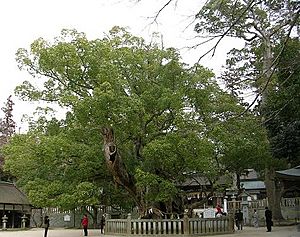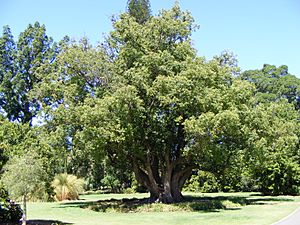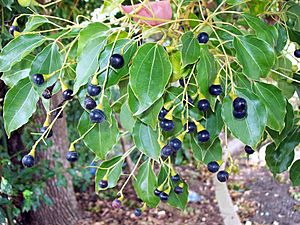Camphora officinarum facts for kids
Quick facts for kids Camphora officinarum |
|
|---|---|
 |
|
| An ancient camphor tree (estimated to be over 1,000 years old) in Japan | |
| Scientific classification | |
| Genus: |
Camphora
|
| Species: |
officinarum
|
| Synonyms | |
|
|
The camphor tree (scientific name: Camphora officinarum) is a type of evergreen tree. This means it stays green all year round. It is also known as camphorwood or camphor laurel.
Contents
Discover the Camphor Tree
The camphor tree originally comes from parts of Asia. You can find it in southern China, Taiwan, southern Japan, Korea, India, and Vietnam. People have also planted it in many other countries around the world.
These trees can grow very tall, reaching up to 20 to 30 meters (about 65 to 98 feet) high. In Japan, where it's called kusunoki, some camphor trees are huge. One famous tree, the Kamō no Ōkusu, has a trunk that is over 24 meters (about 79 feet) around!
What Does a Camphor Tree Look Like?
The leaves of the camphor tree are shiny and waxy. If you crush them, they smell strongly of camphor. In spring, the tree gets bright green leaves and lots of small white flowers. Later, it grows clusters of black, berry-like fruit. These fruits are about 1 centimeter (0.4 inches) wide. The tree's pale bark is rough and has cracks running up and down.
Some camphor trees in Japan are considered very special or holy. For example, there's a 700-year-old camphor tree at Kayashima Station. When the railway station needed to get bigger, local people didn't want the tree moved. So, the station was built right around it!
Uses of Camphor Trees
Camphor trees are grown for two main things: their wood and the substance called camphor. In the past, especially in Taiwan when Japan ruled it (1895–1945), making and shipping camphor was a huge business.
The wood from the camphor tree is special because it helps keep insects away.
What is Camphor?
Camphor is a white, crystal-like substance. It comes from the camphor tree. For hundreds of years, people have used camphor in many ways:
- As a culinary spice in cooking.
- As part of incense, which is burned for its smell.
- As a medicine to help with different health issues.
- As an insect repellent to keep bugs away.
- To kill fleas.
In the past, camphor was also an important ingredient for making things like smokeless gunpowder and a type of plastic called celluloid. To get camphor, workers would chop up the wood. Then, they would steam the wood chips. The steam would carry the camphor, which would then turn into crystals as it cooled. These crystals were collected and sent to factories.
Natural Chemicals in Camphor Trees
All parts of the camphor tree contain special natural chemicals called essential oils. These oils are taken out of the wood and leaves using a process called steam distillation.
Different camphor trees can have slightly different types of these chemicals. For example, camphor trees grown in Taiwan and Japan often have a lot of a chemical called linalool. Trees from India and Sri Lanka usually have more of the camphor chemical itself. Trees from Madagascar often have a lot of 1,8-cineole. The oil from Madagascar trees is sometimes called ravintsara.
Camphor Trees as Invasive Species
While camphor trees are useful, they can also cause problems when they grow in new places. They are considered an invasive species in some countries. This means they spread quickly and can harm local plants and animals.
In Australia

Camphor trees were first brought to Australia in 1822. They were planted as pretty trees in gardens and parks. But in places like Queensland and New South Wales, where the climate is wet and warm, they have become a noxious weed.
Here's why they are a problem:
- Their leaves fall and release camphor, which stops other plants from growing nearby.
- Birds eat the seeds and then spread them quickly to new areas.
- They can take over rainforests and pastures.
- They compete with native eucalyptus trees. Eucalyptus trees are the only food source for koalas, so this can harm koala populations.
- However, the trees do create hollows quickly, which some native animals can use for shelter. Native trees take much longer to form these hollows.
In the United States
Camphor trees were brought to the contiguous United States around 1875. They have now spread and grown naturally in many states. These include Alabama, California, Florida, Virginia, Georgia, Hawaii, Louisiana, Mississippi, North Carolina, Texas, and South Carolina. In Florida, it has been officially called a category I invasive species. This means it causes a lot of harm to the environment there.
Insect Pests of Camphor Trees
Even though camphor trees are introduced plants in Australia, some native butterflies still use them. The young stages (larvae) of two butterflies, the purple brown-eye and the common red-eye, eat camphor tree leaves.
See also
 In Spanish: Alcanforero para niños
In Spanish: Alcanforero para niños



